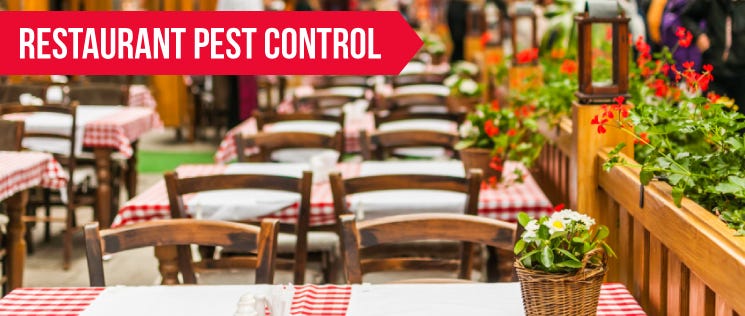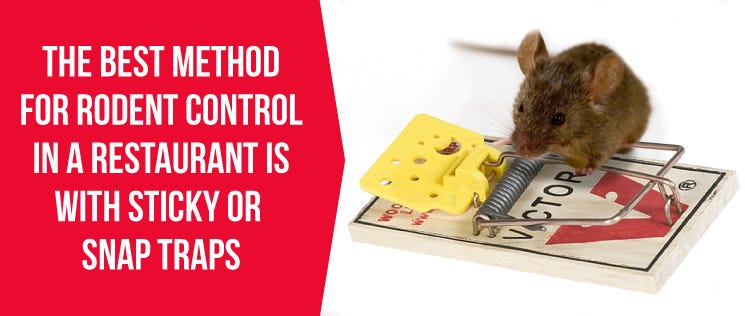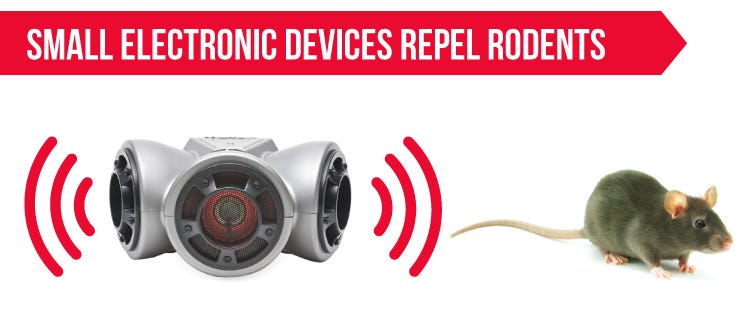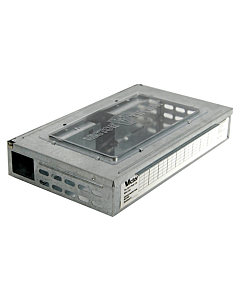
Mice are often depicted as adorable cartoon characters. From Mickey Mouse to Ratatouille, we’ve laughed at their antics for decades. Something about the way they get into trouble and then scurry away before they can be caught makes them seem delightfully playful.
In reality, mice and any other vermin are potentially dangerous pests that are associated with dirt and disease. Attempting to catch the vermin that plague your kitchen seldom leaves a person in a playful mood. Instead it can be frustrating and even frightening.
The situation is even worse if that kitchen belongs to your restaurant. Not only is it creepy to think some little vermin might be watching you as you work, but the reaction it could elicit from your customers if a rodent makes an appearance during dinner service is horrifying.

The Dangers of Real-Life Rodents
In the movies, rat sightings are accompanied by high-pitched screams and people jumping up on chairs. In real life, the reaction to a mouse running across the floor is much the same. Despite their diminutive size, mice strike fear in most people.
There is good reason to fear the presence of rodents in a restaurant. They carry some horrible diseases. Here is a list of diseases that North American rodents can transmit directly to people, according to the Centers for Disease Control and Prevention (CDC):
Leptospirosis – a bacterial disease causing a wide range of symptoms including high fever, headache, vomiting, muscle aches, jaundice, abdominal pain, red eyes, diarrhea, rash and chills. Symptoms may be mistaken for other diseases and in some cases an infected person may have no symptoms at all. It can last a few days or a few weeks. Without treatment, leptospirosis can cause meningitis, liver failure, kidney damage and death.
Lymphocytic Choriomeningitis (LCM)– a rodent-borne viral infection accompanied by fever, malaise, lack of appetite, muscle aches, headache, nausea and vomiting. Lymphocytic choriomeningitis virus (LCMV) can cause increased fluid on the brain requiring surgical shunting. It is easily passed from a pregnant woman to the fetus. If this occurs in the first trimester, the fetus could die. In the second or third trimester, birth defects are possible.

Hantavirus Pulmonary Syndrome – Reported cases every year throughout most of North and South America. Rodents such as Deer mice, Cotton rat, Rice rat, and the White-footed mouse are the primary carriers of the virus. The disease is spread through direct contact or breathing in dust that is contaminated with rodent urine or droppings. Early symptoms include fatigue, fever, muscle aches, stomach problems, dizziness and chills. Late symptoms occur 4 to 10 days after initial infection and include coughing and shortness of breath and lungs filled with fluid.
Plague – a bacterial infection known for causing as many as 100 million deaths in the Middle Ages. There are several different forms of the plague, but they are all very serious diseases which require prompt treatment. Without treatment, plague can damage organs of the body and result in death.
Rat-Bite Fever – Streptobacillary or Rat-Bite-Fever (RBF) is a bacterial infection caused by two different bacteria with diagnosed cases in North America and Asia. Anyone exposed to rats carrying the bacteria is at risk. RBF causes fever, vomiting, headache, muscle pain, joint pain and rash. It can be treated with antibiotics, but if left untreated may be fatal.
Salmonellosis – a bacterial infection is contracted by eating or drinking food or water contaminated by rat feces and spreads from the intestines to the blood stream. Symptoms last four to seven days and include diarrhea, fever and abdominal cramps. Severe cases require hospitalization.
Tularemia – a bacterial infection that can be life-threatening. Exercise caution when cleaning up after a rodent infestation. Rodents can act as a vehicle to carry infected insects such as a tick or deerfly. Improper handling of infected animal carcasses, eating or drinking contaminated food or water, and breathing the bacteria can spread bacterial infection. Symptoms include a skin ulcer where the bacteria entered the body, swollen lymph glands and a fever as high as 104 degrees.
There are also several diseases that mice can transmit indirectly to people, usually through an infected tick, flea or mite. Rodents are not generally affected by the diseases they carry, so it is impossible to identify an infectious rat. As they roam around the kitchen, leaving saliva, urine and feces, vermin spread diseases. This is why pest and rodent control is so important in the restaurant business.
Food Service Health Codes for Rodents
Food service health codes are put in place to protect public health. Because rodents near food present such a potential threat to public safety, there are special provisions to deal with them. The Federal Food and Drug Administration (FDA), along with the U.S. Department of Health and Human Services, set national guidelines for food service.
In the FDA Food Code, rodents are referenced many times. Each section requires strict standards that prevent rodents from getting into or near the building. Even for outside food service, care is taken to keep rodents away. Food dispensers and vending machines must protect the food and beverage in a way that prevents mice from getting into it. Any part of the machine that touches food is designed and installed in a way that prevents rodents from touching it. Once a rodent touches a surface, it is potentially contaminated and cannot come in contact with food.
Disposing of trash is another part of a food service operation that is especially vulnerable to rat contamination. The Food Code spells out that all waste containers, including those used for recycling of empty cans and bottles must be secure. These containers have to be washable, so food residue can be removed to cut down on the possibility of attracting rodents to the area just outside the kitchen where most trash is stored. Once the rats come to the back door, rat pest control gets a lot harder.
Some measures that are recommended in the Food Code for keeping rodents out of a food service establishment are:
- Inspecting incoming shipments of food and supplies
- Regularly inspecting the premises for evidence of pests
- If rodents are found, using accepted pest control methods to remove them
- Eliminating any conditions that would provide a place for rodents to hide
The Food Code also recommends prohibiting any live animals from the premises of a food service establishment. In some areas, pet-friendly restaurants enjoy popularity.
Unfortunately, allowing dogs and cats, even when on a leash, into a cafe or any place that serves food is inviting trouble. Dogs don’t attract rodents but the scent they leave behind might.
Pest Control for Restaurants
There is a lot to consider when setting out to prevent rat infestation in your restaurant. Vigilance is perhaps most important. Keeping a restaurant rodent-free is an ongoing job. Once you establish healthy protocols, you have to follow them continually. Prevention is less costly than elimination. It is worth working hard to keep the rats out in the first place.
There are some atmospheres that favor rats more than others. In many urban areas, the rat population is large and growing. Restaurants there are often sandwiched in between other commercial and residential buildings; they might even share a common wall. Rodents will naturally seek out food, and you can’t control the cleanliness of the neighboring spaces. If the neighbors give mice a safe haven, they’re likely to come next door for a visit.
A restaurant in a remote setting could also be vulnerable. Some people prefer to eat closer to nature. Unfortunately, rodents can be part of that nature. If they follow a trail of breadcrumbs to your kitchen door, you could have a problem. When your restaurant is the only structure around to provide warmth and shelter, the country mouse is more likely to stop by – with all of his friends.
Despite your best efforts, you could end up with mice in your kitchen. Once this happens, you have a few options for safe pest control.

How to Kill Rats and Mice
The best way to kill mice in a restaurant is with sticky or snap traps. Since using chemicals in the vicinity of food preparation or service is hazardous, rat poison really isn’t an option here. Good old-fashioned snap traps always do the job. The trick is setting the trap without snapping it on your finger. The sticky traps work well, too, but it takes longer for the mice to die. Depending on where you have to set the trap, you don’t want to have a live rat stuck to it and flopping around.
For ease of disposal and cleanliness, it is a good idea to lay a small paper bag on its side on the floor with the trap inside it. The rodent will find its way into the bag to get the bait. When he gets stuck in the trap, you can simply pick up the bag and throw the whole thing away. You never have to touch the body or the used trap.
To make things even easier, you can use hygienic traps that kills and seals the rodent inside. Any disease-carrying parasites are sealed in with the mouse, offering an extra layer of protection from disease.
How to Get Rid of a Mouse
Another option to solving a rat problem is to catch the offending critters. There are traps designed to catch mice without killing them. When you use this kind of trap, you should realize that although the rodent is contained, it continues to be a health hazard until you remove him from the premises. Like any trap, you’ll want to check these frequently and deal with them as soon as they are full.
When relocating your mice, take precautions not to touch them with your bare hands or you might be susceptible to whatever disease they are carrying. Also, release the critters far from your restaurant, so they are less likely to find their way back in.

Repelling Rodents
The third option is to repel the creatures. This method allows you to avoid coming in contact with them at all. Rodents do not like certain scents and certain sounds, a fact that rodent control products are based on.
You can purchase small electronic devices that emit an annoying sound to mice that is virtually undetectable by humans. These units plug into a regular outlet and protect the immediate area where they are placed. The sound does not penetrate furniture or walls, though, so separate units are required in each room. Scent repellents are just as easy to use. They look like small sachets or air fresheners and emit an odor known to repel rodents but are not offensive to humans.
Whether you kill, catch or repel rodents, you’ll know the problem is solved when you stop finding rat droppings. Once the infestation is gone, you need to increase your vigilance at keeping them out. Try to find out how the rodents got in and seal up that entry. It could be as easy as filling a small hole in the wall around a pipe or under the door; or your problem might have been caused by leaving items with food residue sitting around too long. Take the time to figure out what caused the breach, because prevention is less costly than the alternative.
Cleaning Up the Mess
In recovering from an infestation, rodent removal is a priority. Cleaning up the mess is essential, too. Since rodents carry serious diseases, it is not enough to simply get the mice out. Everything they have touched is potentially contaminated with infectious bacteria, virus and filth. Cleaning up behind them is an important part of eliminating the problem.
The deadly substances mice leave around are very small if not microscopic. Once a surface is contaminated and you don’t realize it, you could unknowingly spread the contamination to other areas. Getting rid of the visible evidence of a mice infestation doesn’t fully mitigate the danger. You need to assume every surface in the general area is contaminated until you disinfect.
Here is the CDC’s recommended procedure for cleaning up after a rodent infestation:
- Wear gloves when cleaning and be prepared to throw away any rags you use. Paper towels are a good choice, especially for this first step.
- Ventilate the room for several minutes before you begin and continue to air it out after you finish.
- Spray disinfectant on the surface with the droppings and allow it to soak in for a few minutes. Pick up the droppings with a paper towel and put in the garbage.
- Use the spraying/soaking procedure for any dead rodents or nesting materials that remain in the area, as well.
- Clean the floors and surfaces in the entire room with disinfectant. Do not sweep or vacuum to avoid stirring up airborne particles.
- When you’ve finished cleaning, put all used rags, paper towels, debris and your gloves into a trash bag. Seal that trash bag inside another one and dispose of it in a covered trash can or dumpster.
- Wash your hands several times with soap and water.
If the contaminated room contains carpet and upholstered furniture, they should be steam-cleaned with a commercial-grade disinfectant. Any linen affected should be thrown away. Don’t send contaminated linens back to the linen service for laundering. They will be mixed with other linens, potentially spreading the contamination.
Rodents pose a serious health risk which is why they are specifically mentioned in food service health codes. Whether your restaurant is in the city or in the country, food will attract these pesky little critters. The best solution is to take precautions to prevent an infestation. If they do get in, getting rid of the mice as quickly as possible and cleaning thoroughly can reduce the chances of a disease outbreak or a health violation citation. Both could be disastrous to your business.
For more information about how to safely and effectively prevent and combat infestations, contact the experts at Victor®.








